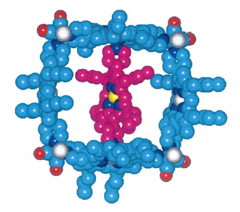 |
|
|
 |
||
|
||||||
|
For more information on these science news and feature story tips, please contact the public information officer at the end of each item at (703) 292-8070. Editor: Peter West Contents of this News Tip:
Tiny Films Have Promising Future as Nanoscale "Filters"
Films such as cell membranes, that allow the passage of some substances while blocking others are ubiquitous in nature. Artificial ones, ranging from the filters in seawater desalination plants to the oxygen-blocking plastic wrap in your kitchen, are also common. Now a research team at Northwestern University, supported by the National Science Foundation (NSF), has developed a thin-film material with nanometer-sized cavities that serves as a molecular gatekeeper. The material can be manipulated to allow the passage of certain molecules on the basis of size, shape and other properties. The scientists -- chemists and chemical engineers Joseph Hupp, SonBinh Nguyen and Randall Snurr -- have also discovered a means of chemically transforming molecules within these cavities. They will report their results in upcoming issues of the European journals Angewandte Chemie and Advanced Materials. The technique involves programmed, directed assembly of nanoscale building blocks, then condensation of the building blocks into arrays. The tiny cavities of the array serve as a filter, but in solution the cavities can also be used to encapsulate catalysts that chemically transform molecules. According to the scientists, a logical next step would be to combine the filtration and catalytic steps. This would allow conversion of plentiful low-cost hydrocarbon molecules into valuable complex molecules with potential applications such as selective drug delivery, synthesis of specialty chemicals or new types of semiconductors. [Amber Jones] Autumn Foliage May Affect Air Quality, ClimateAutumn leaves that light up hillsides also appear to play a role in regional air quality and climate. Scientists funded by NSF and the Environmental Protection Agency and affiliated with the National Center for Atmospheric Research (NCAR) in Boulder, Colorado, are measuring levels of chemicals that are emitted as leaves change color and fall to the ground. Known as volatile organic compounds (VOCs), the chemicals
have wide-ranging effects: they combine with certain
types of industrial emissions to create smog, and
in some cases play a role in global warming. VOCs
are the source of the scents associated with pine
needles and cut grass, and pose no harm in a natural
setting. But they can react with human-generated nitrogen
oxides in the presence of sunlight to form ground-level
ozone, the major component of smog. The emissions
also have an impact on climate by slowing the rate
at which greenhouse gases are oxidized in the atmosphere.
The research is taking place in northern Michigan,
a location chosen because the state’s abrupt, heavy
frosts are likely to result in high levels of emissions. NSF Launches New Industry R&D; On-Line Information Retrieval SystemA new Industrial Research and Development Information System (IRIS) now makes all of NSF's historical data on industrial R&D;, covering a 45-year period, available on-line. The expansive new system provides access to statistics on industrial R&D; performance across a broad range of criteria in about 2,500 statistical tables, and links an on-line interface to historical data. The data "can be used to assess trends in U.S. R&D; performance from a variety of perspectives," says a recent Data Brief from NSF's Division of Science Resources Statistics. The IRIS system not only provides the detailed R&D; statistics over four and a half decades within its historical database, but also provides a glossary of terms, help files and links to related NSF publications in R&D.; IRIS is accessed through a welcome screen that allows observers to browse tables by survey year or topic, and also through a "search for data tables" option. [Bill Noxon] For IRIS on-line, see: http://www.nsf.gov/sbe/srs/iris/start.htm
NSF is an independent federal agency which supports fundamental research and education across all fields of science and engineering, with an annual budget of about $4.5 billion. NSF funds reach all 50 states, through grants to about 1,800 universities and institutions nationwide. Each year, NSF receives about 30,000 competitive requests for funding, and makes about 10,000 new funding awards.
|
||||||
|
|
|
